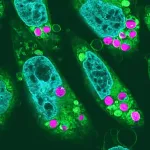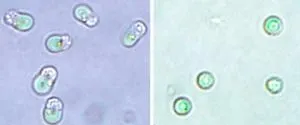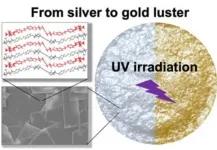(Press-News.org) Energy-making chloroplasts from algae have been inserted into hamster cells, enabling the cells to photosynthesize light, according to new research in Japan. It was previously thought that combining chloroplasts (chlorophyll containing structures in the cells of plants and algae) with animal cells was not possible, and that the chloroplasts would not survive or function. However, results showed that photosynthetic action continued for at least two days. This technique could be useful for artificial tissue engineering. Tissues can struggle to grow due to a lack of oxygen, but adding chloroplast-infused cells could enable oxygen and energy to be supplied through light exposure and photosynthesis.
Would you like to be solar powered? What if, like plants or algae, just lying around in the sun could help you get energy (and not just because of all the vitamin D)? It may seem like science fiction, but some animals have already tapped into this nifty trick. Giant clams, for example, live in a symbiotic relationship with algae. Algae contain chloroplasts, and so can photosynthesize light into food and oxygen. While the clams provide a home for the algae, the algae provide energy to help their amiable hosts thrive.
However, unlike plants and algae, animal cells do not contain chloroplasts. That is until now, as researchers have demonstrated that it is possible to functionally combine the two.
“As far as we know, this is the first reported detection of photosynthetic electron transport in chloroplasts implanted in animal cells,” said Professor Sachihiro Matsunaga of the University of Tokyo, corresponding author of the research paper. Photosynthetic electron transport generates chemical energy and is necessary for numerous cell functions in plants and algae. “We thought that the chloroplasts would be digested by the animal cells within hours after being introduced. However, what we found was that they continued to function for up to two days, and that the electron transport of photosynthetic activity occurred.”
The team inserted chloroplasts from red algae into cultured cells derived from hamsters. The researchers examined the structure of the chloroplasts within the cells via several imaging techniques, including confocal microscopy, superresolution microscopy and electron microscopy. They also measured and confirmed that the electron transport of photosynthetic activity was occurring by using pulses of light (a technique called pulse amplitude modulation fluorometry).
“We believe this work will be useful for cellular-tissue engineering,” said Matsunaga. “Lab-grown tissues, such as artificial organs, artificial meat and skin sheets, are made of multiple layers of cells. However, there is a problem that they cannot increase in size due to hypoxia (low oxygen levels) inside the tissue, which prevents cell division. By mixing in chloroplast-implanted cells, oxygen could be supplied to the cells through photosynthesis, by light irradiation, thereby improving the conditions inside the tissue to enable growth,” he explained.
The team is continuing its research on creating “planimal” cells that can provide the beneficial features of plants to animals. In this study, it found that animal cells which contained chloroplasts experienced an increased cell growth rate, suggesting that the chloroplasts provided a carbon source (fuel) for the host cells. The researchers suggest that future studies could investigate the processes involved in the exchange of substances between the host cell and chloroplasts, as well as what additional substances are produced.
Matsunaga said: “We expect planimal cells to be game-changing cells, which in the future can help us achieve a ‘green transformation’ to a more carbon-neutral society. We will continue to develop innovative biotechnologies with the aim of realizing a sustainable society and the reduction of carbon dioxide emissions.”
#####
Paper
Ryota Aoki, Yayoi Inui, Yoji Okabe, Mayuko Sato, Noriko Takeda-Kamiya, Kiminori Toyooka, Koki Sawada, Hayato Mortita, Baptiste Genot, Shinichiro Maruyama, Tatsuya Tomo, Kintake Sonoike and Sachihiro Matsunaga. Incorporation of photosynthetically active algal chloroplasts in cultured mammalian cells towards photosynthesis in animals. Proceedings of the Japan Academy, Series B, Physical and Biological Sciences. 31 October 2014. DOI. doi.org/10.2183/pjab.100.035
Funding:
This work was supported by grants from JST CREST (JPMJCR20S6), MXT/JSPS KAKENHI (20H03297 and 22H00415) to S.Matsunaga., (21K06101) to T.T., (22H02651 and 23H04961) to K.S., (22H04926) to K.T., (23H04962) to S.Maruyama, and JST SPRING (JPMJSP2108) to R.A.
Conflicts of interest:
The authors have no competing interests to declare.
Useful Links:
Graduate School of Frontier Sciences: https://www.k.u-tokyo.ac.jp/en/index.html
Laboratory of Integrated Biology: https://park.itc.u-tokyo.ac.jp/matsunaga_lab/english/index.html
Research Contact:
Professor Sachihiro Matsunaga
Department of Integrated Biosciences,
Graduate School of Frontier Sciences,
The University of Tokyo, Chiba 277-8562, Japan
Email: sachi@edu.k.u-tokyo.ac.jp
Press contact:
Mrs. Nicola Burghall (she/her)
Public Relations Group, The University of Tokyo,
7-3-1 Hongo, Bunkyo-ku, Tokyo 113-8654, Japan
press-releases.adm@gs.mail.u-tokyo.ac.jp
About the University of Tokyo
The University of Tokyo is Japan’s leading university and one of the world’s top research universities. The vast research output of some 6,000 researchers is published in the world’s top journals across the arts and sciences. Our vibrant student body of around 15,000 undergraduate and 15,000 graduate students includes over 4,000 international students. Find out more at www.u-tokyo.ac.jp/en/ or follow us on X (formerly Twitter) at @UTokyo_News_en.
END
Solar-powered animal cells
Researchers combine chloroplasts from algae with hamster cells
2024-10-30
ELSE PRESS RELEASES FROM THIS DATE:
ACS research finds lack of health insurance coverage contributes to racial and ethnic disparities in advanced-stage diagnosis of multiple cancers
2024-10-30
A new, large study led by American Cancer Society (ACS) researchers found that lack of health insurance coverage accounts for a significant proportion of racial and ethnic disparities in advanced-stage diagnosis of multiple cancers. The findings are published today in the Journal of the National Cancer Institute (JNCI).
“Health insurance coverage is a key determinant of access to high-quality healthcare across the cancer continuum from prevention to early detection, treatment, and survivorship in the United States,” said Dr. Parichoy Pal Choudhury, Principal Scientist, Biostatistics at the American ...
Exploring the cost and feasibility of battery-electric ships
2024-10-30
— By Jessica Scully
Retrofitting a portion of the US shipping fleet from internal combustion engines to battery-electric systems could significantly reduce greenhouse gas emissions and be largely cost effective by 2035, according to a new study from Berkeley Lab researchers recently published in Nature Energy.
Shipping represents 3% of total US greenhouse gas emissions from transportation, making it an important target for decarbonization. But electrifying ships is more challenging than ...
Scientists say plastic on beaches can now be seen from space
2024-10-30
Australian researchers have developed a new method for spotting plastic rubbish on our beaches and successfully field tested it on a remote stretch of coastline.
The satellite imagery tool developed by RMIT University scientists picks up differences in how sand, water and plastics reflect light, allowing plastics to be spotted on shorelines from more than 600km above.
Satellite technology is already used to track the massive amounts of plastic floating around our oceans – from relatively small drifts containing thousands of plastic bottles, bags and fishing nets, up to gigantic ...
New Starr Cancer Consortium grants awarded to Weill Cornell Medicine researchers
2024-10-30
Three teams led by Weill Cornell Medicine scientists have received awards from the Starr Cancer Consortium in its 17th and final annual grant competition. The grants will fund research on the deep mechanisms of common cancers and related treatment strategies.
The Starr Cancer Consortium, established in 2006 with generous support from The Starr Foundation, includes The Broad Institute of MIT and Harvard, Cold Spring Harbor Laboratory, Memorial Sloan Kettering Cancer Center, The Rockefeller University and Weill Cornell Medicine. The consortium’s goal has been to encourage highly collaborative and transformative research on cancer biology and novel treatment strategies. ...
Researchers aim to spark action to address rising homelessness among older people
2024-10-30
Homelessness among people over the age of 50 is on the rise, a phenomenon formal housing strategies often overlook -- but researchers from the University of Toronto and McGill hope to prevent this oversight in the future.
A new study published in The Gerontologist now provides a clear definition of late life homelessness informed by the lives and experiences of older adults. Drawing on interviews with older people who are unhoused and community workers in Montreal, Canada, the researchers aim to spark ...
Comparative metabolism of the humantenirine in liver microsomes from pigs, goats, and humans
2024-10-30
Background and objectives
Gelsemium elegans Benth (G. elegans) is a traditional medicinal plant; however, it is highly toxic, and toxicity varies significantly between species. The cause of this difference has not been clarified. Humantenirine is an important toxic alkaloid in G. elegans, and its metabolism has been poorly studied. This study aimed to compare the different metabolites formed by human liver microsomes, pig liver microsomes, and goat liver microsomes.
Methods
High-performance liquid chromatography/quadrupole time-of-flight mass spectrometry was used to study the metabolism of humantenirine in human liver microsomes, ...
Some wildfire suppressants contain heavy metals and could contaminate the environment
2024-10-30
In fire-prone areas, water isn’t the only thing used to quell blazes. Wildland firefighters also apply chemical or synthetic suppressants. Researchers reporting in ACS’ Environmental Science & Technology Letters explored whether these suppressants could be a source of elevated metal levels sometimes found in waterways after wildfires are extinguished. Several products they investigated contained high levels of at least one metal, including chromium and cadmium, and could contribute to post-fire increases in the environment.
“Wildfires ...
McMahon receives NIH grant to help build TTUHSC research capacity
2024-10-30
As a leader in academic health and biomedical research training, the Texas Tech University Health Sciences Center (TTUHSC) covers the West Texas region that comprises half of the state’s land mass and is home to 10% of its population. Research at TTUHSC drives innovation and discovery, changing the lives of those it serves and attracting talented faculty, staff and students.
During the latest reporting period (2020-2022), TTUHSC received an average of $12,539,679 annually in National Institutes ...
Turning silver to gold: A diacetylene derivative-based metallic luster materials
2024-10-30
Societies of the past and present have given high regard to precious metals like gold and silver. Both metals remind us of nobility and luxury. However, they are quite expensive, which restricts their applications. Therefore, materials with attractive but artificial gold- and silver-like metallic lusters are popular, finding use in jewelry, reflective materials, inks, and cosmetics.
Unfortunately, typical metallic luster materials cause environmental harm, rendering them unsustainable. Thus, scientists are actively searching for metal-free alternatives. In this direction, the research fraternity ...
Faster space communication with record-sensitive receiver
2024-10-30
In space exploration, long-distance optical links can now be used to transmit images, films and data from space probes to Earth using light. But in order for the signals to reach all the way and not be disturbed along the way, hypersensitive receivers and noise-free amplifiers are required. Now, researchers at Chalmers University of Technology, in Sweden, have created a system that, with a silent amplifier and record-sensitive receiver, paves the way for faster and improved space communication.
Space communication systems are increasingly based on optical laser beams rather than radio waves, as the signal loss has been shown to be less when light is used ...
LAST 30 PRESS RELEASES:
Drone sampling of whale breath reveals first evidence of potentially deadly virus in Arctic
Roman soldiers defending Hadrian’s Wall infected by parasites, study finds
Pinochet’s prisoners were tormented with music but still found solace in it, a new book reveals
Fertility remains high in rural Tanzania despite access to family planning
AI-assisted device can improve autism care access
Kinetic careers
Uncovering how parasitic plants avoid attacking themselves to improve crop resistance
Nanoparticle vaccine strategy could protect against Ebola and other deadly filoviruses
Study finds brain care score can predict risk of stroke across racial groups
Key lung immune cells can intensify allergic reactions
Do hormones explain why women experience more gut pain?
New materials conduct ions in solids as easily as in liquids
Breakthrough of the Year: Renewable energy begins to eclipse fossil fuel-based sources
LLM use is reshaping scientific enterprise by increasing output, reducing quality and more
Introducing LightGen, a chip for ultra-fast, ultra-efficient generative AI
Astronomers see fireworks from violent collisions around nearby star
ACC/AHA issue new guideline on managing congenital heart disease in adults
Cosmic crash caught on camera
Is talented youth nurtured the wrong way? New study shows: top performers develop differently than assumed
Ants: An untapped resource in the development of antibiotics?
Archaeologists use AI to create prehistoric video game
Mitochondria migrate toward the cell membrane in response to high glucose levels
Tiny viral switch offers hope against drug-resistant bacteria
Most parents aware of early peanut introduction guidelines, but confused about details
HPV vaccine can protect against severe lesions of the vulva and vagina
Virtual care provision and emergency department use among children and youth
Quadrivalent HPV vaccine and high-grade vulvovaginal lesions
Insights into dry eyes gained from stem cell-derived tear glands
Researchers identify 166 human pluripotent stem cell lines available for use in clinical applications
Europa Clipper instrument uniquely observed interstellar comet 3I/ATLAS
[Press-News.org] Solar-powered animal cellsResearchers combine chloroplasts from algae with hamster cells






